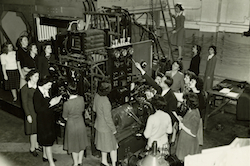Archivist's Angle: The History of Engineering at NYU
The founders of New York University had envisioned a place where young men could study to become, among other things, “mechanics…architects…or civil engineers.” Specialized schools of engineering were uncommon in America before the Civil War, but NYU formally founded the School of Civil Engineering and Architecture in 1854, making it the fourth oldest American engineering college that has continuously offered curricula leading to degrees. Classes began in 1855, and the first undergraduate degree was awarded in 1857.
At that time, the prevalent notion about education for engineers was that engineers required no formal schooling and could learn all they needed through self-instruction. NYU’s School of Engineering ran counter to this line of thinking and produced, even very early on, a number of notable alumni. George Brown Post, a student in the first engineering class, designed the New York Stock Exchange. The first true skyscraper was designed by John W. Root, class of 1869. And Isaac Newton, who graduated in 1856, would help to design and later man the engine controls of the USS Monitor, the first ironclad warship commissioned by the US during the Civil War.

An engineering class in a chemical lab in 1894
Towards the end of the 19th century, a quickening industrial economy required more and more engineers with formal schooling. The School of Engineering moved from Greenwich Village to the new University Heights campus in the Bronx, along with the rest of the undergraduate college of NYU in 1894. In 1896, Charles H. Snow took office as the school’s first dean, and in 1899, the school’s name was changed to the School of Applied Science and was officially separated from University College. By the 1908-09 academic year, the number of students had grown to 277. During World War I, numerous draftees known as the “Fighting Mechanics,” as well as 1,600 Student Army Training Corps, were trained in auto mechanics, radio operation, and carpentry at the school.
In 1920, the name changed yet again, this time to the College of Engineering, and separate electrical and chemical engineering departments were created. Evening classes began to be offered for full degree credit in 1922, and by 1935, the college was one of only two that had been accredited by the Engineers Council for Professional Development. Two years later, a separate Graduate Division of Engineering was created. During World War II, the College of Engineering’s 17 defense courses were overwhelmed, and civilian students were put on an accelerated trimester to allow for more training in a shorter amount of time. Although at that time the college usually excluded women from enrolling in day classes, an exception was made and 125 women enrolled in day courses in engineering to allow them to work in the aviation industry in response to the wartime manpower shortage.

Women attending the School of Aeronautics at NYU in 1943
NYU’s engineering school merged with the Polytechnic Institute of Brooklyn in 1973 to become the Polytechnic Institute of New York. This move occurred when the University Heights campus was sold to the City of New York in an effort to improve the school’s serious financial situation. Most of the engineering faculty who had been teaching at University Heights campus moved to the Polytechnic Institute. In 2008, the affiliation between NYU and Polytechnic University (formerly Polytechnic Institute of New York) was reaffirmed and strengthened. Now called Polytechnic Institute of New York University (NYU-Poly), the campus is located in Brooklyn and the school is considered an affiliate of New York University. Both undergraduate and graduate degrees are offered, and programs of study include civil, chemical, computer, mechanical, information systems, and electrical engineering, among others.
NYU-Poly has also created several incubators throughout the city that were designed to provide the guidance, expertise, and resources that startup businesses need to grow into successful ventures and bring economic growth to New York City. Business Insider recently singled out NYU-Poly’s Varick Street Incubator as “a shining example and roadmap for other cities to follow on how to foster tech innovation.”
Additionally, NYU has responded to the City of New York’s call to create a new institute of applied science and engineering with a proposal to create the Center for Urban Science and Progress (CUSP) in downtown Brooklyn. NYU and NYU-Poly have forged an impressive consortium of leading universities and leaders in the technology industry to establish the new Center. CUSP will be an applied science institute focused on researching and developing new solutions for the pressing and complex challenges that confront the world’s urban growth. The project is the latest element in the long evolution of engineering at NYU.
For further reading on New York University’s plans for CUSP, visit http://www.nyu.edu/about/university-initiatives/center-for-urban-science... .
This article originally appeared in the November issue of the NYU alumni newsletter, Connect.




